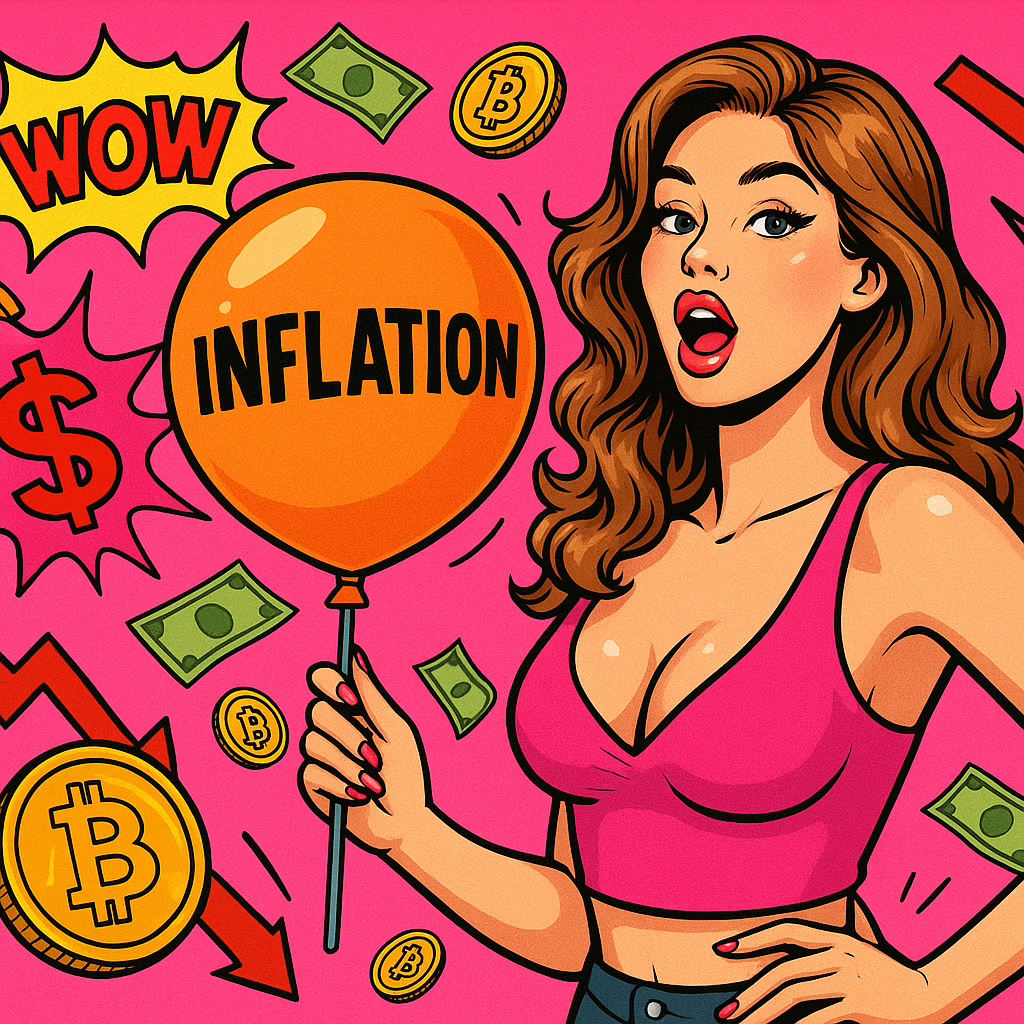Inflation Gone Wild! Here Are 10 Direct Effects on Bitcoin’s Price
In the past few years, the financial world has been rocked—again—by runaway global inflation.
Governments everywhere have been printing money like there’s no tomorrow to save their economies, and as a result, fiat currencies are losing value fast.
Amid all this chaos, Bitcoin steps into the spotlight like some kind of digital golden child, hailed as a potential savior of purchasing power. But… is it really that simple?
Principal Conclusions
Hide-
Bitcoin as a hedge: It's often seen as a store of value when fiat currencies weaken.
-
Volatility is real: Inflation fuels sharper short-term price moves.
-
Institutional demand rising: Big players are slowly embracing Bitcoin as part of diversified portfolios.
-
Stock market connection: Bitcoin often moves with equities, especially under tight monetary policy.
-
Fee pressure from inflation: Rising energy and mining costs push up transaction fees.
Let’s break down what’s actually going on between Bitcoin and inflation—no drama, just real talk backed by facts.
1. Bitcoin: The “Digital Hedge” in an Age of Price Madness
Imagine a world drowning in printed money, and you’re holding an asset with a hard cap on its supply.
That’s the core reason why so many see Bitcoin as a hedge against inflation. There will only ever be 21 million BTC. That’s it. No more.
After the most recent halving, Bitcoin’s issuance rate dropped to around 0.84% per year—way lower than the U.S. inflation rate of 3.4% as of May 2024.
Compare that with the dollar or other fiat currencies that can lose value simply because central banks decide to tweak policies.
For many investors, especially those losing trust in traditional finance, Bitcoin looks like an oasis in a desert of inflation.
But don’t get it twisted—“hedge” doesn’t mean invincible. Bitcoin isn’t a magical anti-crisis talisman. It still has a wild side you really need to understand before jumping in.
2. Volatility: The Heart-Racing Side of Bitcoin
Even with hedge potential, Bitcoin’s price can spike or crash hard—and fast. Take CPI announcements for example: after the U.S. drops inflation data, Bitcoin can swing 10% up or 12% down in just 24 hours.
So yeah, long-term it might be promising, but short-term? It’s a financial roller coaster. The highs and lows are real, and not everyone’s ready for that level of emotional turbulence.
If you’re considering investing in crypto, don’t just chase the upside—be mentally prepared for the chaos too.
3. Institutional Investors: From Skeptics to Bitcoin Bros
Once dismissed as a playground for tech nerds and rebel investors, Bitcoin is now being eyed by pension funds, hedge funds, and major corporations.
Why? Because in an inflationary world, diversifying your assets isn’t a luxury—it’s a necessity.
For these big players, Bitcoin isn’t just a hype train—it’s a strategic move to safeguard portfolios if the traditional financial system takes a hit. Even a small BTC allocation can make a big difference.
But here’s the twist: as more institutions join the game, macroeconomic forces start having a heavier influence on Bitcoin. In other words, risk and reward both level up.
4. Odd but True: Bitcoin Sometimes Moves Like a Stock
People like to think of Bitcoin as anti-mainstream, totally separate from Wall Street. But in reality? It often moves with global stock markets—especially when central banks like the Fed tighten up liquidity.
So when interest rates spike and stocks tank, Bitcoin tends to dip too. That’s the reality: even though it’s pitched as a hedge or alternative asset, BTC isn’t immune to broader economic stress. Sometimes, it acts more like a tech stock in crypto clothing.
5. Interest Rates: The Silent Killer for Bitcoin
One of the big ripple effects of inflation? Central banks raising interest rates. And when that happens, investors shift toward fixed-income options with actual yield—like bonds—instead of holding non-yield assets like Bitcoin.
This leads to selling pressure on BTC. Plus, for miners, things get tougher. Energy prices go up, gear gets more expensive, but earnings don’t necessarily rise to match. That balance problem? It can mess with the whole Bitcoin ecosystem.
6. Transaction Fees: When Mining Gets Expensive, We Pay for It
Miners are the backbone of the Bitcoin network. But with rising costs—electricity, hardware, maintenance—mining profitability starts to shrink. To stay in the green, miners either need to cut costs or raise fees.
What does that mean for us? Higher transaction fees. And if sending a small amount costs more than the actual transfer, that’s a pretty big barrier. Not exactly user-friendly.
7. Young Investors: Balancing Hype and Reality
Surveys show that millennials and Gen Z trust Bitcoin more than traditional banks. The reasons? Easy access, digital-native systems, and a serious distrust of the institutions that sparked multiple financial crises.
To them, Bitcoin isn’t just an investment—it’s a movement. It’s borderless, decentralized, and (in theory) more democratic.
But this excitement needs to be balanced with education. It’s not enough to ride the wave—you’ve gotta know what you’re surfing.
8. Regulation: A Double-Edged Sword of Progress and Panic
As more countries roll out crypto regulations, the industry is getting clearer frameworks. That’s a win for institutional adoption.
But here’s the catch: every time a new law or crackdown hits the headlines, Bitcoin prices can spiral. Regulation is a tricky beast. It can legitimize crypto in one place and restrict it in another.
What’s legal in Country A might be banned in Country B. So even as the rules get written, uncertainty never really leaves the room.
9. Bitcoin vs Gold: Who’s the Real Safe Haven?
Bitcoin’s often dubbed “digital gold,” but when real-world crises hit—like geopolitical conflicts—gold still dominates as the go-to safe haven. Why? Gold has a proven track record that spans centuries.
Bitcoin? It’s still the new kid on the block. Yes, it has potential, and yes, sometimes it rallies alongside gold. But other times? Bitcoin drops hard while gold climbs. Bottom line: it’s not a perfect substitute—at least, not yet.
10. Global Crises: The Unexpected Triggers of Chaos
The world’s never truly stable. Wars, disasters, oil spikes—they all impact crypto markets. Sometimes, Bitcoin jumps as inflation fears rise. But other times, it tanks because investors pull out to protect cash flow.
Take the Middle East conflict, for example. Oil prices soar, inflation fears rise, but liquidity dries up.
That kind of squeeze can stop Bitcoin’s rally before it even starts. It’s a delicate dance between fear, money flow, and macro triggers.
Conclusion: Bitcoin Isn’t a Savior—It’s Just One Piece of the Puzzle
Inflation definitely makes Bitcoin look more attractive, but let’s not pretend it’s the answer to everything.
It’s not a financial silver bullet—it’s more like a powerful tool, one that works best when used strategically and with eyes wide open.
If you’re thinking about diving into Bitcoin, don’t just look at the gains. Understand the full picture—from technicals and fundamentals to market psychology.
Because behind all the hype and headlines, Bitcoin is one of the most dynamic, complicated, and fascinating assets of our generation.
Frequently Asked Questions (FAQs)
Can Bitcoin really protect against inflation?
Yes, to some extent. Bitcoin’s fixed supply gives it anti-inflation appeal, but its short-term volatility can’t be ignored.
How do interest rates affect Bitcoin?
Higher rates make fixed-income assets more attractive, pulling capital away from Bitcoin and other risk assets.
Why do Bitcoin transaction fees rise during inflation?
Because mining costs (especially energy) rise, and miners adjust fees to stay profitable.
Is Bitcoin correlated with gold?
Not consistently. Gold usually outperforms during geopolitical crises, while Bitcoin reacts more erratically.
Should institutions buy Bitcoin in high inflation times?
Many do for diversification, but it requires proper risk management and long-term thinking.







